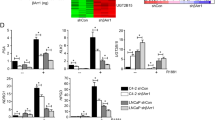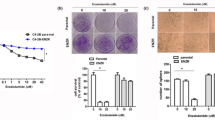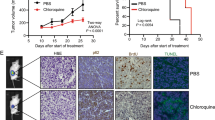Abstract
Castration-resistant prostate cancer (CRPC) continues to be a major clinical problem and the mechanisms behind it remain unclear. Thioredoxin domain-containing protein 5 (TXNDC5) is involved in protein folding and chaperone activity, and its overexpression has been reported in multiple malignancies. In the current study, we demonstrated that TXNDC5 is up-regulated following long-term androgen-deprivation treatment (ADT) and is highly overexpressed in CRPC tumors compared with hormone-naive prostate cancer (PCa) cases. Functionally, in vitro and in vivo studies demonstrated that TXNDC5 overexpression promotes the growth of both androgen-dependent and castration-resistant PCa xenografts. Mechanistically, TXNDC5 directly interacts with the AR protein to increase its stability and thus enhances its transcriptional activity. TXDNC5-mediated CRPC growth can be fully abolished by AR inhibition, suggesting TXDNC5 up-regulation as an escape pathway for aberrant AR re-activation and CRPC growth in the milieu of low androgen. Indeed, we found that TXNDC5 is increased by ADT-induced hypoxia through HIF-1α in an miR-200b-dependent manner. Overall, we defined an important role of TXNDC5 in CRPC and further investigations are needed to screen TXNDC5 antagonists as a novel therapeutic approaches to treat PCa patients with CRPC.
This is a preview of subscription content, access via your institution
Access options
Subscribe to this journal
Receive 50 print issues and online access
$259.00 per year
only $5.18 per issue
Buy this article
- Purchase on Springer Link
- Instant access to full article PDF
Prices may be subject to local taxes which are calculated during checkout







Similar content being viewed by others
References
Zhao L, Yu N, Guo T, Hou Y, Zeng Z, Yang X et al. Tissue biomarkers for prognosis of prostate cancer: A systematic review and meta-analysis. Cancer Epidemiol Biomarkers Prev 2014; 23: 1047–1054.
Baumann C, Behbahani TE . EAU guidelines for prostate cancer: to screen or not to screen? Actas Urol Esp 2012; 36: 1.
Scher HI, Sawyers CL . Biology of progressive, castration-resistant prostate cancer: directed therapies targeting the androgen-receptor signaling axis. J Clin Oncol 2005; 23: 8253–8261.
Sharifi N . Mechanisms of androgen receptor activation in castration-resistant prostate cancer. Endocrinology 2013; 154: 4010–4017.
Egan A, Dong Y, Zhang H, Qi Y, Balk SP, Sartor O . Castration-resistant prostate cancer: adaptive responses in the androgen axis. Cancer Treat Rev 2014; 40: 426–433.
Fujino G, Noguchi T, Takeda K, Ichijo H . Thioredoxin and protein kinases in redox signaling. Semin Cancer Biol 2006; 16: 427–435.
Zhu X, Huang C, Peng B . Overexpression of thioredoxin system proteins predicts poor prognosis in patients with squamous cell carcinoma of the tongue. Oral Oncol 2011; 47: 609–614.
Tonissen KF, Di Trapani G . Thioredoxin system inhibitors as mediators of apoptosis for cancer therapy. Mol Nutr Food Res 2009; 53: 87–103.
Ramanathan RK, Stephenson JJ, Weiss GJ, Pestano LA, Lowe A, Hiscox A et al. A phase I trial of PX-12, a small-molecule inhibitor of thioredoxin-1, administered as a 72-hour infusion every 21 days in patients with advanced cancers refractory to standard therapy. Investnew Drugs 2012; 30: 1591–1596.
Gulerez IE, Kozlov G, Rosenauer A, Gehring K . Structure of the third catalytic domain of the protein disulfide isomerase ERp46. Acta Crystallogr Sect F Struct Biol Cryst Commun 2012; 68: 378–381.
Sullivan DC, Huminiecki L, Moore JW, Boyle JJ, Poulsom R, Creamer D et al. EndoPDI, a novel protein-disulfide isomerase-like protein that is preferentially expressed in endothelial cells acts as a stress survival factor. J Biol Chem 2003; 278: 47079–47088.
Wei Q, Li M, Fu X, Tang R, Na Y, Jiang M et al. Global analysis of differentially expressed genes in androgen-independent prostate cancer. Prostate Cancer P D 2007; 10: 167–174.
Inoue T, Ogawa O . Role of signaling transduction pathways in development of castration-resistant prostate cancer. Prostate Cancer 2011; 2011: 647987.
Pal SK, Stein CA, Sartor O . Enzalutamide for the treatment of prostate cancer. Expert Opin Pharmacother 2013; 14: 679–685.
Messaoudi S, Peyrat JF, Brion JD, Alami M . Recent advances in Hsp90 inhibitors as antitumor agents. Anti-Cancer Agent Med 2008; 8: 761–782.
Ni L, Yang CS, Gioeli D, Frierson H, Toft DO, Paschal BM . FKBP51 promotes assembly of the Hsp90 chaprone complex and regulates androgen receptor signaling in prostate cancer cell. Mol Cell Biol 2010; 30: 1243–1253.
Ranasinghe WK, Sengupta S, Williams S, Chang M, Shulkes A, Bolton DM et al. The effects of nonspecific HIF1alpha inhibitors on development of castrate resistance and metastases in prostate cancer. Cancer Med 2014; 3: 245–251.
Wang L, Zheng Y, Xu H, Yan X, Chang X . Investigate pathogenic mechanism of TXNDC5 in rheumatoid arthritis. PLoS ONE 2013; 8: e53301.
Chan YC, Khanna S, Roy S, Sen CK . miR-200b targets Ets-1 and is down-regulated by hypoxia to induce angiogenic response of endothelial cells. J Biol Chem 2011; 286: 2047–2056.
Wang Y, Ma Y, Lu B, Xu E, Huang Q, Lai M . Differential expression of mimecan and thioredoxin domain-containing protein 5 in colorectal adenoma and cancer: a proteomic study. Exp Biol Med 2007; 232: 1152–1159.
Vincent EE, Elder DJ, Phillips L, Heesom KJ, Pawade J, Luckett M et al. Overexpression of the TXNDC5 protein in non-small cell lung carcinoma. Anticancer Res 2011; 31: 1577–1582.
Zhang L, Hou Y, Li N, Wu K, Zhai J . The influence of TXNDC5 gene on gastric cancer cell. J Cancer Res Clin 2010; 136: 1497–1505.
Thoenes L, Hoehn M, Kashirin R, Ogris M, Arnold GJ, Wagner E et al. In vivo chemoresistance of prostate cancer in metronomic cyclophosphamide therapy. J Poteomics 2010; 73: 1342–1354.
Galluzzi L, Giordanetto F, Kroemer G . Targeting HSP70 for cancer therapy. Mol Cell 2009; 36: 176–177.
Wang YT, Qin WJ, Liu Q, Li YL, Liang H, Chen F et al. Chaperone heat shock protein 70 in nucleus accumbens core: a novel biological target of behavioural sensitization to morphine in rats. Int J Neuropsychoph 2014; 17: 469–484.
Hsieh CL, Cai C, Giwa A, Bivins A, Chen SY, Sabry D et al. Expression of a hyperactive androgen receptor leads to androgen-independent growth of prostate cancer cells. J Mol Endocrinol 2008; 41: 13–23.
Lillig CH, Holmgren A . Thioredoxin and related molecules—from biology to health and disease. Antioxid Redox Sign 2007; 9: 25–47.
Linnik KM, Herscovitz H . Multiple molecular chaperones interact with apolipoprotein B during its maturation. The network of endoplasmic reticulum-resident chaperones (ERp72, GRP94, calreticulin, and BiP) interacts with apolipoprotein b regardless of its lipidation state. J Biol Chem 1998; 273: 21368–21373.
Charlton HK, Webster J, Kruger S, Simpson F, Richards AA, Whitehead JP . ERp46 binds to AdipoR1, but not AdipoR2, and modulates adiponectin signalling. Biochem Biophys Res Commun 2010; 392: 234–239.
Leo S, Accettura C, Lorusso V . Castration-resistant prostate cancer: targeted therapies. Chemotherapy 2011; 57: 115–127.
Mellinghoff IK, Vivanco I, Kwon A, Tran C, Wongvipat J, Sawyers CL . HER2/neu kinase-dependent modulation of androgen receptor function through effects on DNA binding and stability. Cancer cell 2004; 6: 517–527.
Hsu FN, Yang MS, Lin E, Tseng CF, Lin H . The significance of Her2 on androgen receptor protein stability in the transition of androgen requirement in prostate cancer cells. Am J Physiol Endocrinol Metab 2011; 300: E902–E908.
Lin HK, Hu YC, Yang L, Altuwaijri S, Chen YT, Kang HY et al. Suppression versus induction of androgen receptor functions by the phosphatidylinositol 3-kinase/Akt pathway in prostate cancer LNCaP cells with different passage numbers. J Biol Chem 2003; 278: 50902–50907.
Ranasinghe WK, Xiao L, Kovac S, Chang M, Michiels C, Bolton D et al. The role of hypoxia-inducible factor 1alpha in determining the properties of castrate-resistant prostate cancers. PLoS ONE 2013; 8: e54251.
Mitani T, Yamaji R, Higashimura Y, Harada N, Nakano Y, Inui H . Hypoxia enhances transcriptional activity of androgen receptor through hypoxia-inducible factor-1alpha in a low androgen environment. J Steroid Biochem Mol Biol 2011; 123: 58–64.
Wang L, Li Y, Yang X, Yuan H, Li X, Qi M et al. ERG-SOX4 interaction promotes epithelial-mesenchymal transition in prostate cancer cells. Prostate 2014; 74: 647–658.
Wang L, Chang X, Yuan G, Zhao Y, Wang P . Expression of peptidylarginine deiminase type 4 in ovarian tumors. Int J Biol Sci 2010; 6: 454–464.
Han B, Mehra R, Suleman K, Tomlins SA, Wang L, Singhal N et al. Characterization of ETS gene aberrations in select histologic variants of prostate carcinoma. Modern Pathol 2009; 22: 1176–1185.
Dvorzhinski D, Thalasila A, Thomas PE, Nelson D, Li H, White E et al. A novel proteomic coculture model of prostate cancer cell growth. Proteomics 2004; 4: 3268–3275.
Hu H, Yang Y, Ji Q, Zhao W, Jiang B, Liu R et al. CRL4B catalyzes H2AK119 monoubiquitination and coordinates with PRC2 to promote tumorigenesis. Cancer Cell 2012; 22: 781–795.
Acknowledgements
We thank Professor Yaoqin Gong and Professor Huiqing Yuan from Shandong University Medical School for their critical reading of the manuscript. AR expression and PSA-Luc vectors were kindly provided by Professor Huiqing Yuan. This work was supported by the National Natural Science Foundation of China (Grant No.81302239 and No.81300426) and the Foundation for Scientific and Technological Achievements of Jinan (Grant No.201302046).
Author information
Authors and Affiliations
Corresponding author
Ethics declarations
Competing interests
The authors declare no conflict of interest.
Additional information
Supplementary Information accompanies this paper on the Oncogene website
Supplementary information
Rights and permissions
About this article
Cite this article
Wang, L., Song, G., Chang, X. et al. The role of TXNDC5 in castration-resistant prostate cancer—involvement of androgen receptor signaling pathway. Oncogene 34, 4735–4745 (2015). https://doi.org/10.1038/onc.2014.401
Received:
Revised:
Accepted:
Published:
Issue Date:
DOI: https://doi.org/10.1038/onc.2014.401
This article is cited by
-
PPFIA4 promotes castration-resistant prostate cancer by enhancing mitochondrial metabolism through MTHFD2
Journal of Experimental & Clinical Cancer Research (2022)
-
The role and mechanism of TXNDC5 in diseases
European Journal of Medical Research (2022)
-
METTL3 potentiates progression of cervical cancer by suppressing ER stress via regulating m6A modification of TXNDC5 mRNA
Oncogene (2022)
-
The aberrant upregulation of exon 10-inclusive SREK1 through SRSF10 acts as an oncogenic driver in human hepatocellular carcinoma
Nature Communications (2022)
-
TXNDC12 promotes EMT and metastasis of hepatocellular carcinoma cells via activation of β-catenin
Cell Death & Differentiation (2020)



